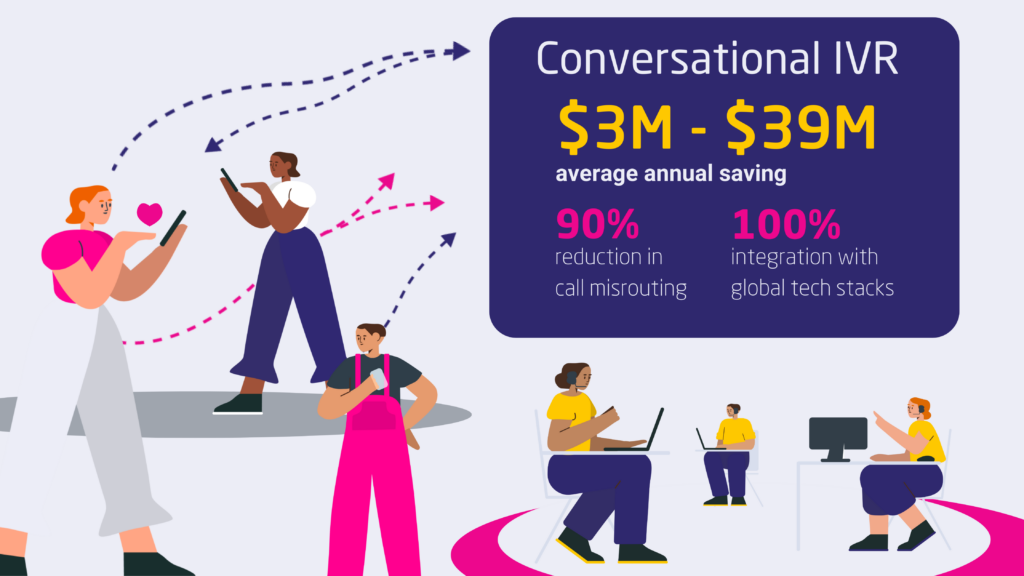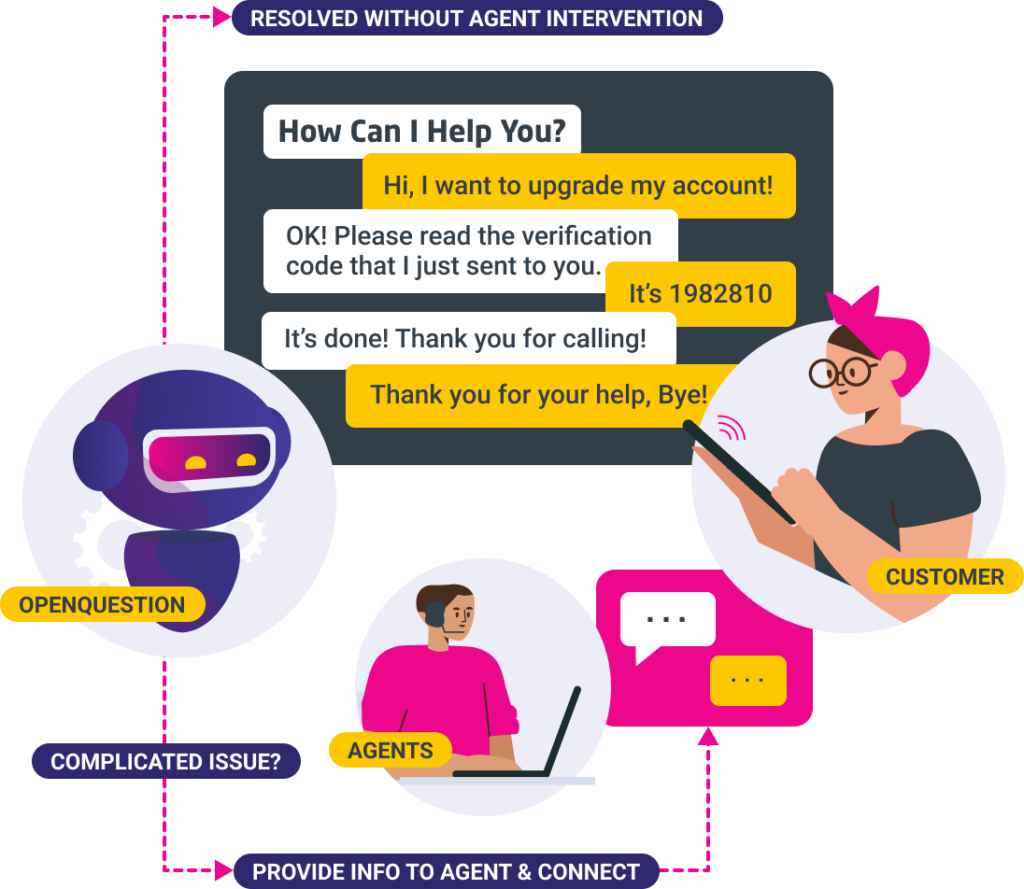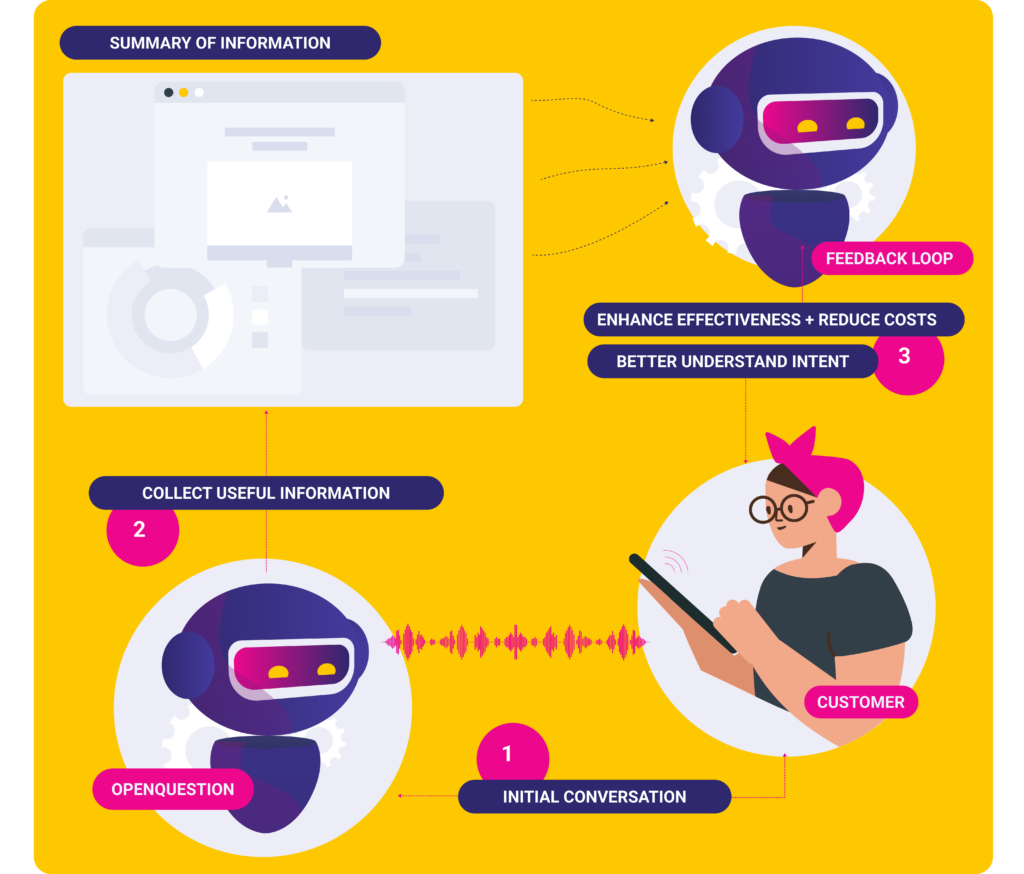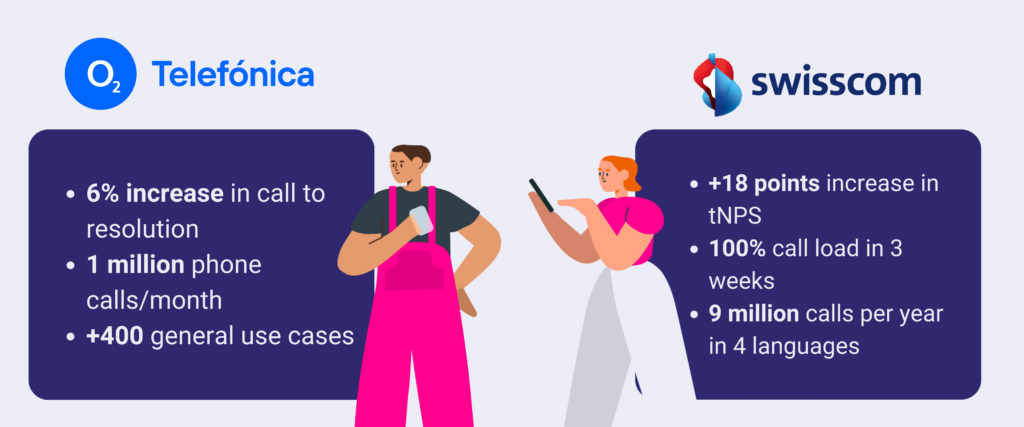
Step into the future of customer service with Conversational AI. This advanced technology is actively revolutionizing contact center operations by providing a seamless, efficient, and personalized customer experience. Our guide will walk you through how Conversational AI works, how it benefits customers and agents, when to use it, and how to optimize it for an enhanced customer experience.
According to a recent report, professionals expect the Conversational AI market to exhibit a remarkable compound annual growth rate (CAGR) of 28.3% during the forecast period from 2022 to 2028. This exponential growth is expected to propel the market value from USD 9.6 billion in 2021 to a staggering USD 46.37 billion by 2028. The increasing demand for effective customer support services is driving this remarkable growth.
Step into the Future with Conversational AI.
What is Conversational AI and How is it Transforming Customer Service
Conversational AI is the combination of machine learning and artificial intelligence technologies, which enables users to engage in natural conversations with a system, just as they would with a real agent. In the realm of customer care, conversational AI is empowering organizations to conduct relevant and authentic customer interactions without the need for human intervention.
Typically, conversational AI is implemented through self-service platforms like chatbots, voice bots and interactive voice response (IVR) systems. These mechanisms strive to comprehend customer queries, discern their intentions and emotions, and respond in a manner that mimics human conversation. In order to ensure effective and efficient customer interactions, we build conversational AI upon a foundation of core principles, which we will look into in the following section.

How Does Conversational AI Work?
Conversational AI systems are built upon a set of core principles that empower machines to understand, analyze, and cater to customer interactions efficiently. In this section, we will delve into these core principles and see how they enhance user interactions, thereby paving the way for improved customer experiences.
Core principles of CAI are:
Natural Language Understanding (NLU): This principle involves teaching AI systems to interpret and analyze human languages, understanding nuances, meanings, and intents behind messages. It utilizes machine learning algorithms to achieve this understanding.
Intent Recognition: Intent recognition focuses on identifying the purpose of a conversation and generating appropriate responses. By analyzing user input using language processing algorithms, conversational AI systems can provide relevant and efficient answers to queries.
Context Awareness: Context awareness enhances the AI’s response capabilities by analyzing available customer data. This includes examining the customer’s purchase or interaction history, preferences, and geographic location to gain a comprehensive understanding of their query and provide suitable resolutions.
Personalization: Personalization in customer care involves understanding user interests, preferences, and needs by analyzing previous interactions. It enables conversational AI systems to deliver better, more relevant responses tailored to individual users. Meanwhile context awareness focuses on the current conversation, personalization primarily leverages data from past interactions to understand customer requirements.
Continuous Learning: Continuous learning is a crucial trait of conversational AI that facilitates improvement over time. Through natural language processing and machine learning algorithms, AI systems can learn from each interaction and adapt to enhance their understanding of human speech and behavior. This principle allows for evolving experiences that meet the changing needs of customers.
For these reasons and more, CAI shows immense promise in meeting the long-standing desires of both organizations and customers alike: a swift, streamlined, and tailored customer service experience. It achieves this by seamlessly integrating with chatbots and IVR technology.
Ready to explore how CAI can empower your business?
Next, we will explore the benefits of conversational AI in-depth and discuss how it can improve business operations.
The Impactful Benefits of Conversational AI
Conversational AI has the ability to enhance self-service options, power-up a Conversational IVR, optimize knowledge bases, and empower customers to help themselves. It can also capture key customer information, provide valuable insights.
CAI offers several advantages that positively impact both brands and customers. Here are three key benefits:
Enhanced customer experience:
Conversational AI provides a seamless and intuitive method for customers to interact with businesses. Contact Center solutions powered by CAI possess a deeper understanding of customer queries compared to conventional AI algorithms. This enables them to provide personalized responses that significantly enhance the customer experience. By tailoring interactions to individual needs, CAI promotes customer satisfaction, retention, and loyalty.

Increased efficiency:
By automating repetitive tasks, conversational AI-powered chatbots empower support teams to work more efficiently. Chatbots can handle routine customer inquiries, freeing up customer service representatives to focus on more complex and critical issues. Moreover, CAI provides real-time data and insights, enabling businesses to make faster and more informed decisions. This increased efficiency translates into improved operational productivity and streamlined workflows.
Reduced costs:
Conversational AI helps businesses save money by reducing the need for human labor. By automating routine tasks, companies can decrease operational costs associated with hiring and training additional staff. Furthermore, CAI minimizes the occurrence of errors commonly associated with manual processes, further optimizing resource allocation and reducing expenses.
Businesses worldwide have leveraged various types of conversational AI to reap these benefits and optimize their operations. In the next section, we will explore the major types of CAI and examine how they have enhanced productivity in different industries.
Types of Conversational AI Technologies: Powering the Customer Experience
Conversational AI technology comes in various forms, including chatbots, voice assistants, and Interactive Voice Response (IVR) systems. Each type of technology has its unique features and can be used in different ways to optimize customer service. A great customer experience often includes voice experience.
Voice technologies involve the utilization of voice recognition and synthesis in conversational AI to engage with customers. These technologies are commonly employed through devices like smart speakers or virtual assistants. Currently, two primary types of voice technologies are being utilized:
Voice bots: Voice bots utilize voice recognition and synthesis to interact with customers and engage in extensive conversations. They are typically accessed through devices like smart speakers or virtual assistants. When it comes to customer care, voice bots’ function similarly to rule-based chatbots, relying on a predetermined set of voice prompts and responses. However, they may not be very effective when customers require information outside the scope of their programmed capabilities.
Interactive Voice Assistants (IVAs): IVAs are voice-activated virtual assistants that employ natural language processing and machine learning to comprehend customer queries and provide relevant responses. Within customer care, IVAs enable the system to handle comprehensive customer conversations seamlessly, without requiring agent intervention.
Now, let’s delve into the workings of these distinct technologies. In the subsequent section, we will explore the key components of any conversational AI system and how they collaborate to enhance the efficiency of your customer service workflow.
How to improve your Contact Center with AI?
Real-world Examples: Conversational AI in Action
Various industries utilize Conversational AI in diverse ways. For starters, it provides around-the-clock support, offers self-service options, and delivers personalized recommendations in the customer service sector. Moving forward, it converts leads and drives sales in sales and marketing. Furthermore, it functions for data collection and even serves in Internet of Things (IoT) devices.
Telefónica implemented a Conversational AI-solution, OpenQuestion, which significantly improves customer engagement. They saw a 6% increase in call-to-resolution and were able to handle 1 million phone calls per month.

Swisscom built and developed a range of conversational voice solutions. They experienced a 21% increase in correct transfers, an 18-point increase in tNPS, and were able to handle 100% of their call load in 3 weeks across 9 million calls per year in 4 languages.

In a significant advancement, Škoda Auto developed a conversational solution named ‘Laura’. Subsequently, they witnessed a 100% surge in customer requests and a staggering 400% increase in test drive bookings during the first trial phase. Moreover, they expanded their solution to cover 13 European regions without experiencing any system downtime. As a direct consequence, ‘Laura’ now provides highly personalized recommendations to drivers reviewing ŠKODA’s products. Notably, tens of thousands of additional customers began interacting with the solution as it launched in new regions.
Impressed by these success stories? Let’s write yours.
How to Successfully Implement Conversational AI in Your Operations
Implementing Conversational AI involves several steps, including establishing your goals and use cases, getting support from stakeholders, determining your budget and resources, considering your existing infrastructure, choosing and connecting your CRM, and looking at data to measure performance.
Best Practices for Maximizing Conversational AI’s Potential
To get the most out of your Conversational AI, it’s important to follow best practices. These include creating an easy handoff from bot to agent, meeting the customer on their preferred channels, matching your AI’s personality to your brand’s tone, and keeping up with AI advances. Learn from real AI-implementations and find out how to:
- Implement skill-based routing to connect callers with the most qualified agent
- Deploy virtual assistant capabilities within an IVR system
- Focus on customer experience management and implementing customer feedback mechanisms
- Leverage GPT for your IVR interactions
- Implement best practice call center strategies.
- Strive for first call resolution and regularly monitoring key performance indicators

Conversational AI is the future of customer service. Significantly, not only does it make it easier and faster for customers to get answers to simple questions, but it also liberates support agents to address complex questions that AI can’t handle. By combining the strengths of AI tools and humans, companies can provide a better customer experience and improve their bottom line.

